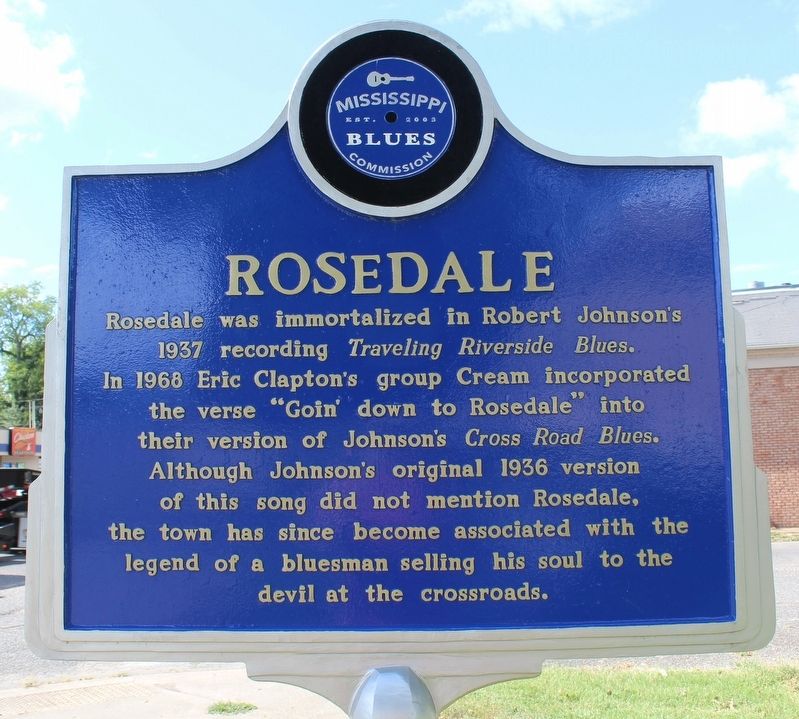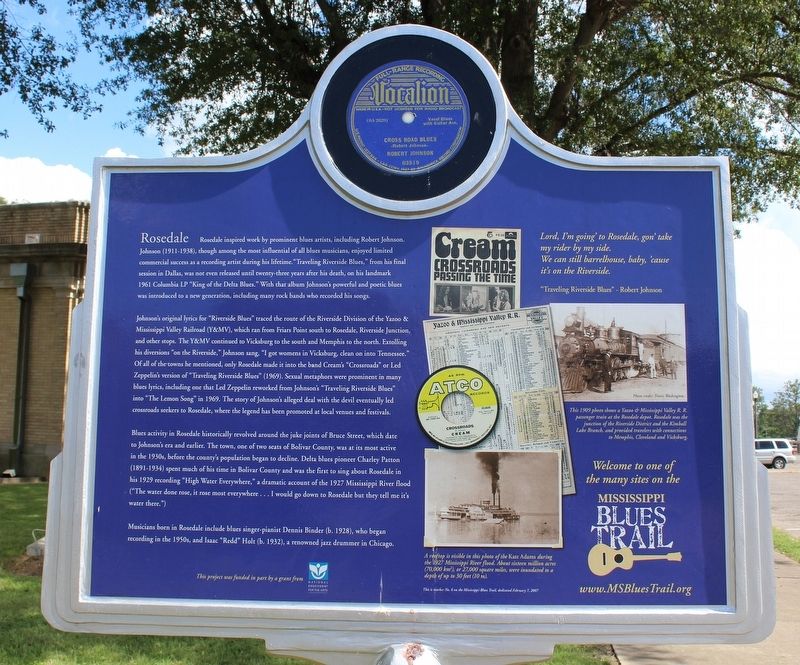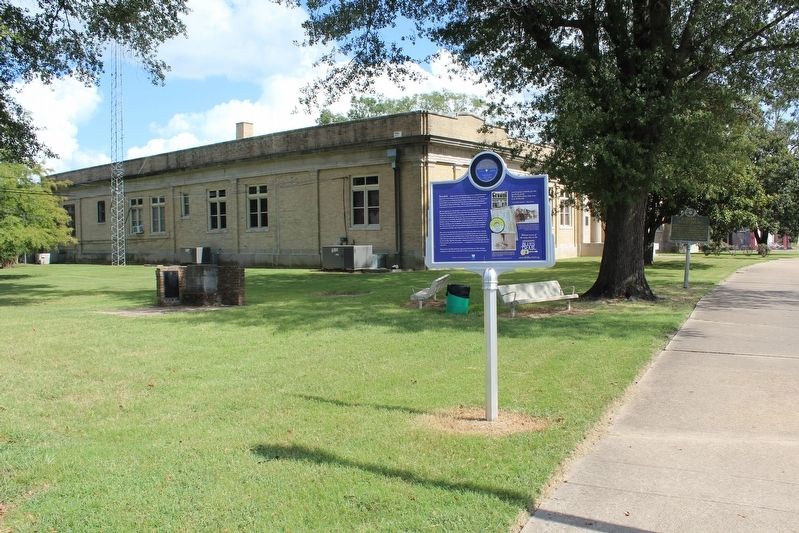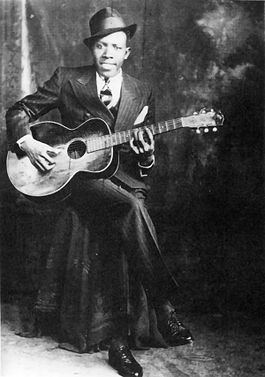Rosedale in Bolivar County, Mississippi — The American South (East South Central)
Rosedale
Rosedale was immortalized in Robert Johnson's 1937 recording Traveling Riverside Blues. In 1968, Eric Clapton's group Cream incorporated the verse "Goin' down to Rosedale" into their version of Johnson's Cross Road Blues. Although Johnson's original 1936 version of this song did not mention Rosedale, the town has since become associated with the legend of a bluesman selling his soul to the devil at the crossroads.
(back)
Rosedale Rosedale inspired work by prominent blues artists, including Robert Johnson. Johnson (1911-1938), though among the most influential of all blues musicians, enjoyed limited commercial success as a recording artist during his lifetime. "Traveling Riverside Blues," from his final session in Dallas, was not even released until twenty-three years after his death, on his landmark 1961 Columbia LP King of the Delta Blues. With that album Johnsonís powerful and poetic blues was introduced to a new generation, including many rock bands who recorded his songs.
Johnsonís original lyrics for "Riverside Blues" traced the route of the Riverside Division of the Yazoo & Mississippi Valley Railroad (Y&MV), which ran from Friars Point south to Rosedale, Riverside Junction, and other stops. The Y&MV continued to Vicksburg to the south and Memphis to the north. Extolling his diversions "on the Riverside," Johnson sang, "I got womens in Vicksburg, clean on into Tennessee." Of all of the towns he mentioned, only Rosedale made it into the band Creamís "Crossroads" or Led Zeppelinís version of "Traveling Riverside Blues" (1969). Sexual metaphors were prominent in many blues lyrics, including one that Led Zeppelin reworked from Johnsonís "Traveling Riverside Blues" into "The Lemon Song" in 1969. The story of Johnsonís alleged deal with the devil eventually led crossroads seekers to Rosedale, where the legend has been promoted at local venues and festivals.
Blues activity in Rosedale historically revolved around the juke joints of Bruce Street, which date to Johnsonís era and earlier. The town, one of two seats of Bolivar County, was at its most active in the 1930s, before the countyís population began to decline. Delta blues pioneer Charley Patton (1891-1934) spent much of his time in Bolivar County and was the first to sing about Rosedale in his 1929 recording "High Water Everywhere," a dramatic account of the 1927 Mississippi River flood ("The water done rose, it rose most everywhere...I would go down to Rosedale but they tell me it's water there.")
Musicians born in Rosedale include blues singer-pianist Dennis Binder (b. 1928), who began recording in the 1950s, and Isaac "Redd" Holt (b. 1932), a renowned jazz drummer in Chicago.
(captions)
Lord, Iím goiní to Rosedale, goní take my rider by my side. We can still barrelhouse, baby, Ďcause itís on the Riverside. “Traveling Riverside Blues” – Robert Johnson
This 1909 photo shows a Yazoo & Mississippi Valley R.R. passenger train at the Rosedale depot. Rosedale was the junction of the Riverside District and the Kimball Lake Branch, and provided travelers with connections to Memphis, Cleveland and Vicksburg.
Erected 2007 by Mississippi Blues Commission. (Marker Number 6.)
Topics and series. This historical marker is listed in these topic lists: African Americans • Arts, Letters, Music • Disasters • Entertainment. In addition, it is included in the Mississippi Blues Trail series list. A significant historical year for this entry is 1937.
Location. 33° 51.245′ N, 91° 1.648′ W. Marker is in Rosedale, Mississippi, in Bolivar County. Marker is at the intersection of Main Street (State Highway 1) and Dr Martin Luther King Street, on the right when traveling north on Main Street. Touch for map. Marker is in this post office area: Rosedale MS 38769, United States of America. Touch for directions.
Other nearby markers. At least 8 other markers are within 14 miles of this marker, measured as the crow flies. To Memorialize Bolivar County's First Two Brick Courthouses (here, next to this marker); Rosedale Courthouse (a few steps from this marker); Hot Tamales and the Blues (about 700 feet away, measured in a direct line); Grace Episcopal Church (approx. 0.2 miles away); Mildrette Netter (approx. half a mile away); Otis Clay (approx. 5.7 miles away); Christmas Mound (approx. 6.4 miles away); Eddie Shaw (approx. 14.1 miles away). Touch for a list and map of all markers in Rosedale.
Credits. This page was last revised on August 16, 2020. It was originally submitted on August 15, 2020, by Tom Bosse of Jefferson City, Tennessee. This page has been viewed 645 times since then and 102 times this year. Photos: 1, 2, 3, 4. submitted on August 15, 2020, by Tom Bosse of Jefferson City, Tennessee. • Bernard Fisher was the editor who published this page.



